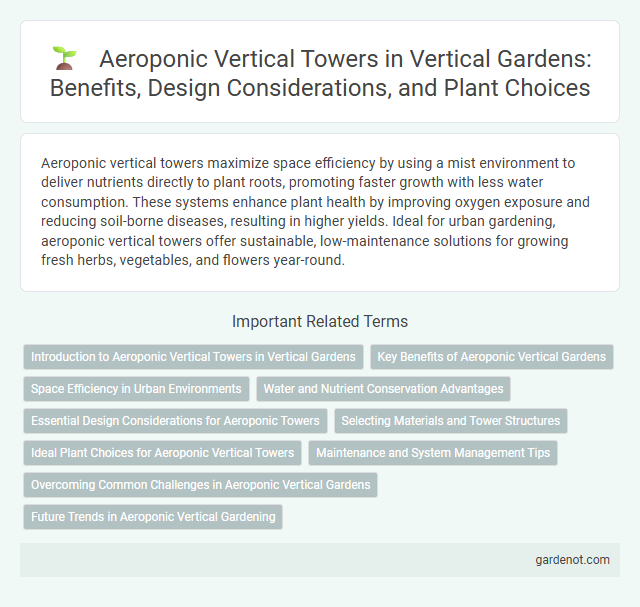Aeroponic vertical towers maximize space efficiency by using a mist environment to deliver nutrients directly to plant roots, promoting faster growth with less water consumption. These systems enhance plant health by improving oxygen exposure and reducing soil-borne diseases, resulting in higher yields. Ideal for urban gardening, aeroponic vertical towers offer sustainable, low-maintenance solutions for growing fresh herbs, vegetables, and flowers year-round.
Introduction to Aeroponic Vertical Towers in Vertical Gardens
Aeroponic vertical towers in vertical gardens utilize a soil-free growing method where plant roots are suspended in air and periodically misted with nutrient-rich solutions, optimizing water use efficiency and nutrient absorption. This innovative system enhances space utilization by allowing plants to grow upwards, making it ideal for urban environments with limited ground area. Aeroponic towers support faster growth cycles and higher yields compared to traditional soil gardening, promoting sustainable and resource-efficient urban farming.
Key Benefits of Aeroponic Vertical Gardens
Aeroponic vertical gardens maximize space efficiency by allowing plants to grow upwards in nutrient-rich mist environments, resulting in faster growth rates and higher crop yields. This soil-free system reduces water usage by up to 90% compared to traditional agriculture, promoting sustainable urban farming. Enhanced root oxygenation in aeroponic towers improves plant health and nutrient absorption, leading to superior quality produce.
Space Efficiency in Urban Environments
Aeroponic vertical towers maximize space efficiency by utilizing vertical growth techniques that require minimal floor area, making them ideal for urban environments with limited space. These towers support high-density planting and improve aeration, leading to faster plant growth and higher yields in compact urban settings. Implementing aeroponic systems reduces the need for soil and water, further optimizing resource use in constrained urban spaces.
Water and Nutrient Conservation Advantages
Aeroponic vertical towers use mist to deliver water and nutrients directly to plant roots, significantly reducing water consumption compared to traditional soil farming. This precise delivery system minimizes nutrient runoff, improving nutrient uptake efficiency and reducing waste. The closed-loop design supports sustainable water recycling, promoting eco-friendly vertical gardening practices.
Essential Design Considerations for Aeroponic Towers
Aeroponic vertical towers require essential design considerations such as ensuring optimal air circulation and consistent misting of nutrient solutions to maximize root oxygenation and nutrient absorption. The tower's structural materials must be durable, UV-resistant, and non-toxic to support plant health and longevity. Integration of efficient water recycling systems and easy access for maintenance enhances sustainability and operational efficiency in aeroponic vertical gardens.
Selecting Materials and Tower Structures
Selecting materials for an aeroponic vertical tower requires prioritizing durability, lightweight properties, and resistance to moisture and UV exposure; high-density polyethylene (HDPE) and food-grade plastics are commonly chosen for their non-toxic and corrosion-resistant characteristics. Tower structures should facilitate optimal water and nutrient flow while maximizing vertical space to support crop diversity and healthy root aeration. Incorporating modular designs with removable components enhances maintenance efficiency and scalability in vertical gardening systems.
Ideal Plant Choices for Aeroponic Vertical Towers
Leafy greens such as lettuce, spinach, and kale thrive exceptionally well in aeroponic vertical towers due to their fast growth rates and shallow root systems. Herbs like basil, mint, and cilantro are ideal choices because they require minimal space and benefit from the high oxygen levels provided by aeroponics. Strawberries and small fruiting plants also adapt successfully, maximizing yields in compact vertical setups optimized for nutrient mist delivery.
Maintenance and System Management Tips
Regularly inspect aeroponic vertical towers to ensure mist nozzles remain unclogged and nutrient solutions are balanced for optimal plant hydration and growth. Implement a consistent cleaning schedule to prevent algae buildup and monitor pump functionality to maintain efficient nutrient delivery. Use automated timers and sensors to streamline system management, enhancing overall maintenance efficiency and plant health.
Overcoming Common Challenges in Aeroponic Vertical Gardens
Aeroponic vertical towers address common challenges such as water usage inefficiency and root oxygenation by delivering nutrient-rich mist directly to plant roots, enhancing growth and minimizing resource waste. These towers optimize space utilization in urban environments, combating limited growing areas while maintaining high yields through precise environmental control. Advanced aeroponic systems also reduce pest and disease exposure, promoting healthier plants without relying heavily on pesticides.
Future Trends in Aeroponic Vertical Gardening
Aeroponic vertical towers are set to revolutionize urban farming by maximizing space efficiency and reducing water usage up to 90% compared to traditional soil gardening. Advancements in sensor technology and AI integration are enabling precise nutrient delivery and real-time system monitoring, enhancing plant growth and yield. Future trends emphasize sustainable materials and modular designs to facilitate scalability and customization for diverse indoor and outdoor environments.
Aeroponic vertical tower Infographic

 gardenot.com
gardenot.com